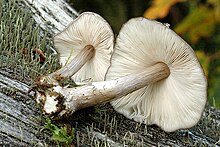Pluteus
| Pluteus | |
|---|---|
 |
|
| Pluteus cervinus | |
| Scientific classification | |
| Kingdom: | Fungi |
| Division: | Basidiomycota |
| Class: | Agaricomycetes |
| Order: | Agaricales |
| Family: | Pluteaceae |
| Genus: |
Pluteus Fr. |
| Type species | |
|
Pluteus cervinus (Schaeff.) P.Kumm. |
|
| Species | |
|
Pluteus brunneidiscus |
|
| Pluteus | |
|---|---|
| Mycological characteristics | |
| gills on hymenium | |
|
|
cap is flat or convex |
| hymenium is free | |
| stipe is bare | |
| spore print is pink | |
| ecology is saprotrophic | |
|
|
edibility: edible or psychoactive |
Pluteus brunneidiscus
Pluteus cervinus
Pluteus cyanopus
Pluteus glaucus
Pluteus leoninus
Pluteus nevadensis
Pluteus nigroviridis
Pluteus readiarum
Pluteus salicinus
Pluteus villosus
cap is flat
edibility: edible
Pluteus is a large genus of fungi with over 300 species. They are wood rotting saprobes with pink spore prints and gills that are free from the stem.
Pluteus means shed or penthouse.
Pluteus is separated from Volvariella due to the lack of a volva, and from Entoloma by growing on wood and by microscopic features (Entolomas have angular spores).
Some of these mushrooms are edible including P. petasatus and P. cervinus, though most people rate their taste and consistency as average at best.
Pluteus cervinus is the best known species in Europe and North America.
Several species of this genus bruise blue and contain psilocybin including Pluteus brunneidiscus,Pluteus salicinus, Pluteus cyanopus, Pluteus glaucus, Pluteus nigroviridis, Pluteus phaeocyanopus and Pluteus villosus.
...
Wikipedia
